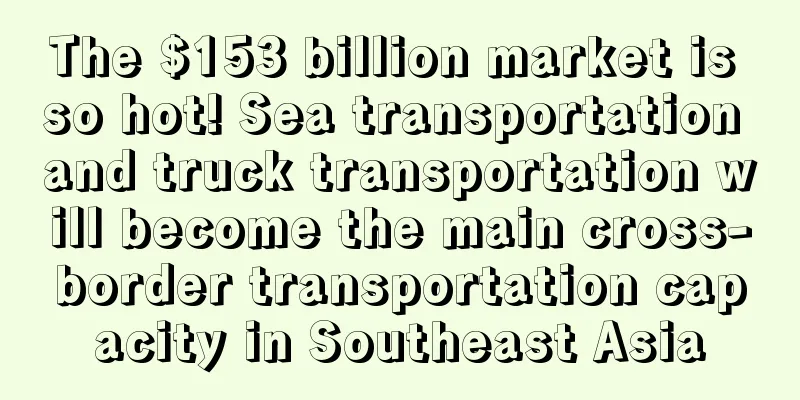The $153 billion market is so hot! Sea transportation and truck transportation will become the main cross-border transportation capacity in Southeast Asia

|
The COVID-19 pandemic has accelerated online spending in the region, with the market expected to reach $153 billion in sales by 2025, according to regional e-commerce logistics company J&T Express. This was a prediction made before the pandemic, and as online shopping for goods continues to expand, J&T predicts that more goods will shift to ocean freight. This shift will be driven primarily by consumers purchasing larger items and pressure on merchants to reduce shipping costs. Such drives will become even more relevant with the recent announcement that low-value goods purchased online and imported (to Singapore) by air or post will be subject to Goods and Services Tax (GST) from January 1, 2023. It is understood that J&T also has operations in Malaysia , Vietnam , the Philippines , Thailand , Cambodia and China. Since its establishment in 2015, its business has grown by 300% annually and it claims to be one of the fastest growing e-commerce logistics companies in these regions . J&T believes that sea freight is becoming the main mode of transport in Southeast Asia , as anywhere beyond this will require longer delivery times. In response to this shift, J&T ’s infrastructure and systems are seeking ways to better integrate retail , trade and logistics processes to support ocean shipping as a key link in the cross-border e-commerce supply chain. However, in the current global shipping environment, the shortage of containers has had a significant impact on it , thereby pushing up the cost of completing cross-border e-commerce transportation. In 2021, with the resumption of air cargo, the pressure on sea freight may be reduced. On the other hand , due to the reduction in air cargo volume, some freight forwarders in Southeast Asia have also increased their freight volume to cross-border truck transportation . For e-commerce , the use of road freight in Southeast Asia is somewhat limited compared to Europe , due to "customs clearance issues between different countries in Asia." However, it cannot be ignored that there is a certain growth trend in cross-border truck transportation throughout Asia, and cross-border business in these countries is also favored due to lower transportation costs and relatively short delivery times. There is also the recently launched ASEAN Customs Transit System , which many cross-border e-commerce players hope will improve the efficiency of cross-border truck transport. logistics Cross-border e-commerce market Southeast Asia |
<<: Malaysia Airlines passenger traffic still down, cargo traffic continues to climb
>>: Online GMV reaches $6.7 billion, Best Buy accelerates omni-channel transformation
Recommend
What is easipay? easipay Review, Features
<span data-docs-delta="[[20,{"gallery"...
Amazon US updates direct delivery policy, eBay will be able to cancel "timeout and unpaid" orders
Amazon US updates direct delivery policy Recently...
What is Duoyoumi? Duoyoumi Review, Features
Duoyoumi, whose full name is Shenzhen Duoyoumi Net...
What is Damei Store Manager? Damei Store Manager Review, Features
Damei Store Manager is a cross-border store manage...
Amazon files civil lawsuit against five service providers suspected of "fake orders and fake reputation"
Recently, Amazon filed a civil lawsuit in China a...
What is ExportFeed? ExportFeed Review, Features
ExportFeed is plugin that creates your product da...
Hot searches surged to 80,000, and a group of sellers followed suit and may fall into traps
May is coming to an end, but some sellers are sti...
What is amaZervice? amaZervice Review, Features
<span data-docs-delta="[[20,{"gallery"...
Amazon and brands jointly suppress sellers? The two giants face 500 million pounds in compensation
Amazon and Apple are facing a class-action lawsui...
What is Jelly Comb? Jelly Comb Review, Features
Founded in 2014, Jelly Comb is a brand under Seend...
What is royalbaby? royalbaby Review, Features
Royalbaby 's children's bikes are perfectl...
Since March, nearly 3,000 small and medium-sized foreign trade enterprises in Zhejiang have flocked to Alibaba International Station
Alibaba International Station is becoming the fir...
What is Whale Friends Club? Whale Friends Club Review, Features
Whale Friends Club was founded by Musk, Uncle Xia...
Sellers out of stock are anxious! Popular FBA warehouses in the United States are closed and container ships are parked all over the sea
On the first day of official work, many people re...
Impact greater than the Red Sea crisis? Temu and SHEIN's daily cargo volume approaches 10,000 tons
According to data released by Cargo Facts Consult...









